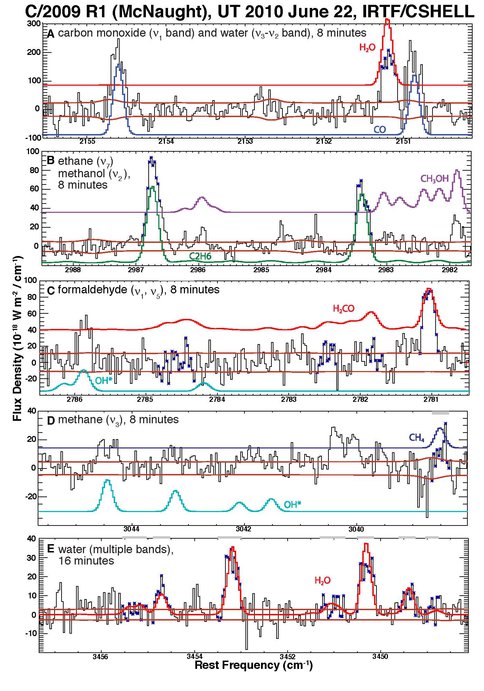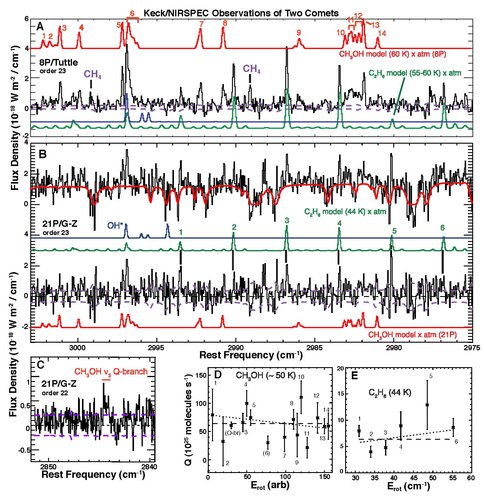2010 Annual Science Report
 NASA Goddard Space Flight Center
Reporting | SEP 2009 – AUG 2010
NASA Goddard Space Flight Center
Reporting | SEP 2009 – AUG 2010
Composition of Parent Volatiles in Comets: Oxidized Carbon
Project Summary
GCA Co-Investigator Dr. Michael DiSanti continued his work on measuring parent volatiles in comets using high-resolution near-infrared spectroscopy at world class observatories. The goal of this work is to build a taxonomy of comets based on ice compositions, which show considerable variation among comets measured to date. DiSanti’s research emphasizes the chemistry of volatile oxidized carbon, in particular the efficiency of converting CO to H2CO and CH3OH on the surfaces of icy interstellar grains, through H-atom addition reactions prior to their incorporation into comets. The work requires planning and conducting observations, processing of spectra, and development and application of fluorescence models for interpretation of observed line intensities. Emphasis of his modeling effort was on characterizing CH3OH in comets.
Project Progress
Project Progress (1 September 2009 – 31 August 2010):
Our studies of native ices in comets (i.e., those contained in the nucleus) have important implications for Astrobiology. These volatiles, which we measure routinely in comets, include several important pre-biotic molecules that are thought to play significant roles in the origin of life on Earth. For example, HCN and NH3 lead to amino acids, H2CO leads to sugars, and CH4 and C2H6 are suggested as respective precursors to the methylamine and ethylamine that were unambiguously identified in Stardust samples returned to Earth from comet 81P/Wild 2.
Co-I DiSanti’s research emphasizes the chemistry of volatile oxidized carbon in comets, in particular the efficiency of converting CO to H2CO and CH3OH on the surfaces of icy interstellar grains, through H-atom addition reactions prior to their incorporation into the nucleus. Laboratory experiments have shown this process to be dependent both on temperatures and H-atom densities in the pre-cometary (interstellar cloud) environment. We see considerable variation among comets, both in abundances of CO, H2CO, and CH3OH (Fig. 1A) and in CO conversion efficiency (Fig. 1B). Such measurements are important for establishing the role of comets in delivering water to Earth along with the seed organic molecules from which life emerged. Our recent observations continue to support compositional diversity among comets (DiSanti and Mumma 2008).
Figure 1. Figure 1. A. Abundances (mixing ratios relative to H2O) of oxidized carbon in several comets. Error bars show 1σ uncertainties, and upper limits ( ) are 3σ. The small beams afforded by modern IR spectrometers favor detection of native ices. B. Corresponding CO conversion efficiencies, expressible as the ratio ([H2CO]+[CH3OH])/([CO]+[H2CO]+[CH3OH]), where [] indicates mixing ratio. This approach assumes that formaldehyde and methanol are produced solely from CO, and that they are the only products. It does not include potential loss of CO (e.g., in the subsequent proto-solar environment) or its incorporation into more complex entities (e.g., polymers such as POM).
We have demonstrated continued productivity in our comet research over the past year. Coordinated observations with Dr. Stefanie Milam, a recent civil service hire at Goddard, were used to investigate the volatile composition of the long-period comet C/2009 R1 (McNaught) in both the infrared (using CSHELL at the IRTF; Figure 2) and millimeter (using the KPNO 12-m)/sub-millimeter (using SMT) (Milam et al., in preparation). At least seven molecular species were detected. This extended our previous effort that led to a paper combining IR and millimeter observations of C/2006 M4 (SWAN), which represented our first effort to measure parent molecules in these two frequency regimes (DiSanti et al. 2009a).
Figure 2. Figure 2. Molecular detections in Comet 2009 R1 (McNaught) using CSHELL, with on-source integration times indicated.
During the current period the fluorescence modeling component of Co-I DiSanti’s work has shifted emphasis from H2CO to CH3OH. This modeling effort has two aspects: (1) A rigorous quantum mechanical application to the ν3 band centered near 2844 cm-1 (3.52 µm), using measured line strengths (near 200 K) together with rotational quantum numbers and energies. (2) An empirical approach to lines in the ν2 band centered near 2999 cm-1 (3.33 µm). Empirical g-factors were established for approximately 50 lines using NIRSPEC spectra of 8P/Tuttle (Figure 3A; see also Figs. 1c and 1d in Bonev et al. 2008 ApJ 680:L61-L64). A high abundance ratio CH3OH/C2H6 (approaching 10) was reported previously from observations of 8P/Tuttle with NIRSPEC (Bonev et al. 2008) and CRIRES (Bohnhardt et al. 2008 ApJ 683:L100-L104). Line assignments and rest frequencies for these ν2 lines were based on laboratory jet-cooled spectra of CH3OH near 20 K (Xu et al. 1997, J. Mol. Sp. 185, 158-172). These empirical g-factors were then applied to the short-period (Jupiter Family) comet 21P/Giacobini-Zinner (Figure 3B). The resulting production rate of CH3OH was consistent with that found from the ν3 Q-branch (Figure 3C), and a similarly high CH3OH/C2H6 was also revealed for 21P (Figures 3D & 3E).
Figure 3. Figure 3. NIRSPEC spectra of the Halley family comet 8P/Tuttle (panel A) and Jupiter family comet 21P/Giacobini-Zinner (panel B). Empirical g-factors for lines in the ν2 band of CH3OH were obtained from the 8P lines based on the production rate (Q) measured from the ν3-band Q-branch intensity (shown for 21P in panel C). Application of these to 13 spectral intervals (all of those indicated in panel A except number 6) leads to a Q for CH3OH in 21P that is consistent with that found from the Q-branch (panel D). For comparison, a similar analysis for C2H6 is shown in panel E, revealing an abundance ratio CH3OH/C2H6 ~ 10, similar to that found for 8P.
Goals of this Research:
1. Compare modeled and observed H2CO and CH3OH line intensities to accurately measure its abundance in comets, as well as to reveal potential discrepancies between model and data. This involves utilizing comets as test beds for fluorescence models, both quantum mechanical (for both H2CO and CH3OH) and empirical (for CH3OH).
2. Measure relative abundances of CO, H2CO, and CH3OH in observed comets, for comparison with the overall volatile chemistry.
3. From these measured abundances, extend the measurement of CO conversion (see Figure 1) to additional comets, in an attempt to establish the conditions (e.g., H-atom density, temperature) to which the pre-cometary ices were exposed. This requires comparison with yields from irradiation experiments on cometary ice analogues as a function of temperature, and also with observational data on these ices in interstellar and proto-stellar sources.
E/PO activities:
Co-I DiSanti mentored graduate student William Anderson (Catholic U. of America). His thesis topic is the chemistry of oxidized carbon in comet C/2002 T7 (LINEAR), and this work led to the first light curve for a comet based on measurements of multiple parent volatiles. Mr. Anderson currently holds a position in the U.S. Patent Office and his written dissertation is nearing completion.
Co-I DiSanti is the GCA contact for the research effort, within the Minority Institution Astrobiology Cooperative (MIAC), to systematically observe comets through emission-line filters at optical wavelengths using the 1.3-m telescope on Kitt Peak. Dr. Donald Walter (South Carolina State University) leads this effort. Molecules giving rise to the IR emissions are photo-dissociated in the coma, producing the “daughter” fragments (radicals) to be targeted by the MIAC filter imaging program. The intent is to provide early molecular detections of radicals (e.g., C2, CN, OH, NH2, etc.) to assist in evaluating newly discovered comets as Targets-of-Opportunity and to provide production rates and 2-D images for selected daughter volatiles, in support of our principal comet program. For example, simultaneous (or nearly simultaneous) measurements at optical and IR wavelengths can provide information regarding their parentage. GCA provided scientific/technical guidance for the cometary filter set along with funding for their acquisition.
Summer 2010: Co-I DiSanti co-mentored (with GCA Collaborator Dr. Boncho Bonev as primary mentor) undergraduate student Emily Sudholdt (U. Missouri/St. Louis.) through the NAI Summer Undergraduate Intern Associateship (SUIA) program. Ms. Sudholdt’s project during her 10-week internship at the NASA-Goddard Space Flight Center was to compare lines of OH prompt emission (OH*) in comet C/2007 N3 (Lulin) in two separate yet overlapping NIRSPEC settings. Although NIRSPEC has broad spectral coverage, H2O and HDO cannot be sampled simultaneously – these settings were chosen such that one encompasses H2O and OH* and the other encompasses HDO and OH*, with multiple lines of OH* being common to both settings. The science driver behind this project is to use OH*, which is a proxy for H2O, to better constrain the abundance ratio HDO/H2O in comets.
Talks/Presentations
Co-I DiSanti gave an oral talk at the NAI Organics Workshop in March 2010, and also at the Astrobiology Science Conference in April 2010. Both talks concentrated on oxidized carbon in comets.
Refereed Journal Articles during this Reporting Period:
DiSanti, M.A., G.L. Villanueva, S.N. Milam, L.N. Zack, B.P. Bonev, M.J. Mumma, L.M. Ziurys, W.M. Anderson 2009. A multi-wavelength study of parent volatile abundances in comet C/2006 M4 (SWAN). Icarus 203, 589-598.
DiSanti, M.A., G.L. Villanueva, B.P. Bonev, K. Magee-Sauer, J.E. Lyke, M.J. Mumma 2009. Temporal evolution of DI ejecta based on NIRSPEC observations at Keck 2: Parent volatiles and dust. In “Deep Impact as a World Observatory Event: Synergies in Space, Time, and Wavelength,” ESO Astrophysics Symposia, pp. 251-263.
Radeva, Y.L., M.J. Mumma, B.P. Bonev, M.A. DiSanti, G.L. Villanueva, K. Magee-Sauer, E.L. Gibb, H.A. Weaver 2010. The organic composition of Comet C/2000 WM1 (LINEAR) revealed through infrared spectroscopy. Icarus 206, 764-777.
Publications
-
DiSanti, M. A., Villanueva, G. L., Milam, S. N., Zack, L. N., Bonev, B. P., Mumma, M. J., … Anderson, W. M. (2009). A multi-wavelength study of parent volatile abundances in Comet C/2006 M4 (SWAN). Icarus, 203(2), 589–598. doi:10.1016/j.icarus.2009.05.026
-
Radeva, Y. L., Mumma, M. J., Bonev, B. P., DiSanti, M. A., Villanueva, G. L., Magee-Sauer, K., … Weaver, H. A. (2010). The organic composition of Comet C/2000 WM1 (LINEAR) revealed through infrared spectroscopy. Icarus, 206(2), 764–777. doi:10.1016/j.icarus.2009.09.014
- DiSanti, M.A., Villanueva, G.L., Bonev, B.P., Magee-Sauer, K., Lyke, J.E. & Mumma, J.M. (2009). Temporal evolution of DI ejecta on MIRSPEC observations at Keck2: Parent volatiles and dust. ESO Astrophysics Symposia.
-
PROJECT INVESTIGATORS:
-
RELATED OBJECTIVES:
Objective 3.1
Sources of prebiotic materials and catalysts



